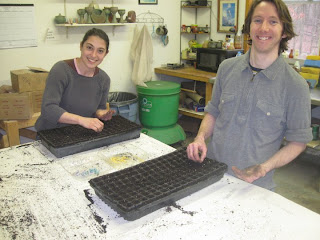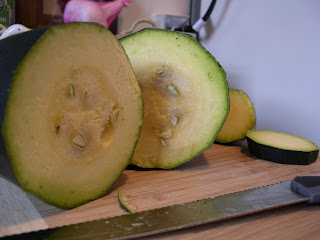My friends have pointed out recently that I haven't written much on the Garden Variety Philosopher about my pottery adventures. I think that's because I hadn't really achieved a balance yet between creating something in pottery that has a real purpose, beyond just being a well-designed vessel for something. People ask me whether I'm a ceramicist or a potter. I'm not sure of the difference technically, but I think I'm a potter. I don't create things to be works of art, I create things to serve a function. (Of course, if they do that elegantly, they're the best kind of art.) But last night, I was finally able to let one of my best original pottery designs fulfill its purpose in my kitchen and my cooking. Here's the story:
About four months ago, I decided to throw a pizza stone in pottery class. I chose a really dark grog-heavy clay (lots of grit) called Laguna, and threw it as if it were a giant plate with no rim. It was perfectly flat save for some throw lines, and about 3/8 inch thick. A

fter I finished, I decided to let it spin on the wheel while I drizzled some white slip over it for decoration. My amazing pottery teacher Mike had the foresight to yell, STOP! when I'd added enough white slip to create a good design, before I overdid it. As it dried on my teacher's shelf for about a month (thanks for your patience Mike!!) we watched anxiously to see if it would warp or crack. It was ready for the bisque kiln with a slight warp and no cracks. When it came out of the bisque kiln, though, the warp had gotten bad enough that I wasn't sure I wanted to put it through the second firing (no glaze on a pizza stone, of course). But, a leap of faith and $15 in firing tickets later, it came out less warped than it had been before! I thought, this is actually kind of good!
And then - Now that it's done, I might have to actually make pizza...
So of course, nearly every week after Mike would ask me if I'd made pizza yet. Last night I finally did! I'd been worried about how to transfer dough to the oven with the stone already in the oven for the pre-heating stage, which is necessary for pottery. Then at the farm on Sunday, the amazing baker Silke suggested I use parchment paper to transfer the pizza from wooden cutting board to the hot pizza stone in the oven. It worked perfectly.
I've always been a big fan of making dough, but since I wasn't sure how this experiment would go I decided to control one more variable and just get store-made dough. I put the pizza stone in the oven and got to preparing some toppings. I caramelized some onions with bacon, added some sage, salt and pepper, and sliced up some apples and sharp cheddar. When the oven was at 425 (I know, I'm a wimp. Higher temp next time) I put the dough in to pre-cook. That step turned out to not even be necessary with the even heat from the pizza stone. Then I took out the dough, knocked some air out of it since it had puffed up a little, and put the toppings on for its second round in the oven. Less than five minutes later, I had amazing homemade pizza! Crunchy crust, perfectly cooked.
I think a lot of restaurants are beginning to understand how much joy it can bring people when you join good cooking with locally farmed ingredients. Pottery is the missing piece in this emerging convergence. At Mike's farm each Sunday, eating just-picked salads and drinking wine out of pottery that was also made by hand results in this same happy energy.
For me, the pizza stone experiment taught me that not only can I take mud and make a plate, or a bowl, to serve food I have made to friends and family; but I can also create something that then has a role to play all its own in my kitchen, and helps me make something I could never have dreamed of making without it. It's a handmade world, so come join the adventures!
Send me your favorite pizza topping combinations, because I think I'm going to be living on pizza for awhile... and come out to the farm on Sundays to join experiments with grilled pizza (not to mention, to learn bio-intensive farming techniques!). And let me know if you're so inspired that you need a pizza stone. Loving homes only!
























